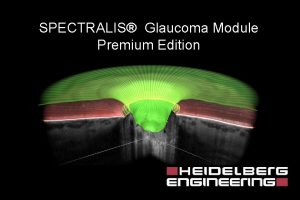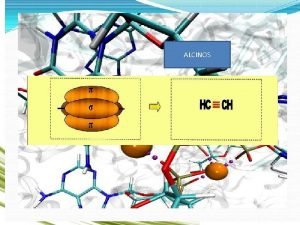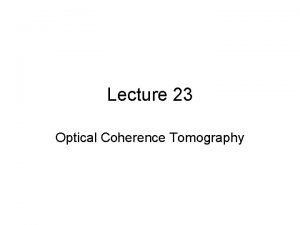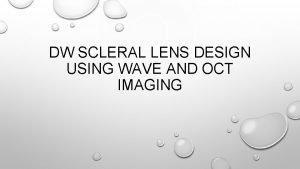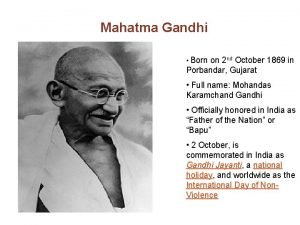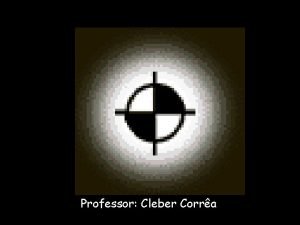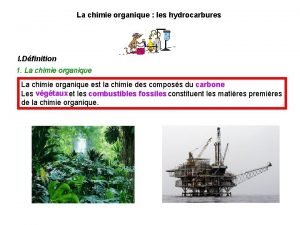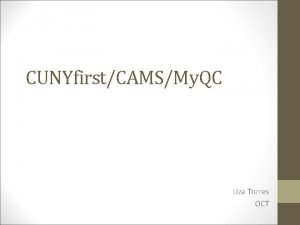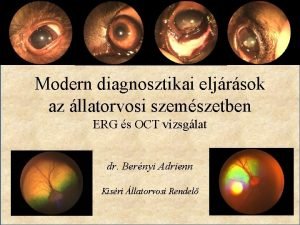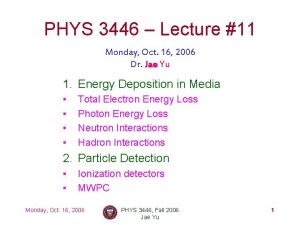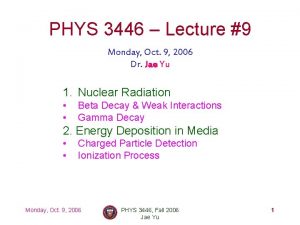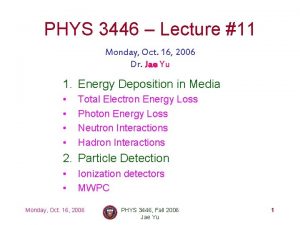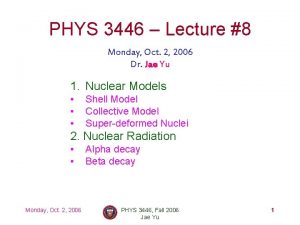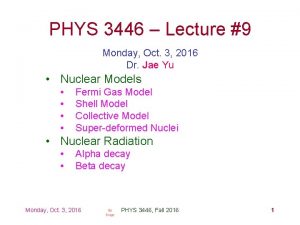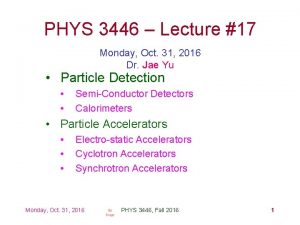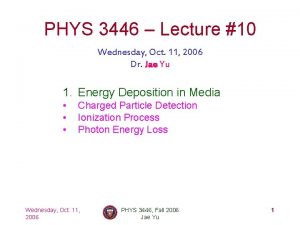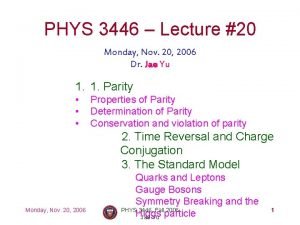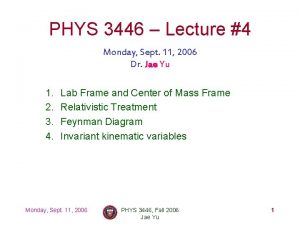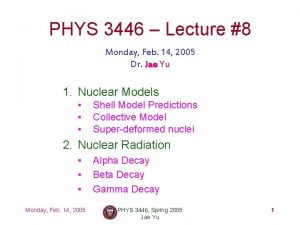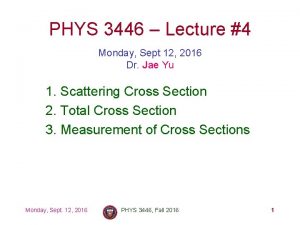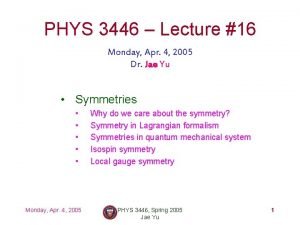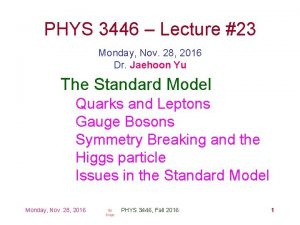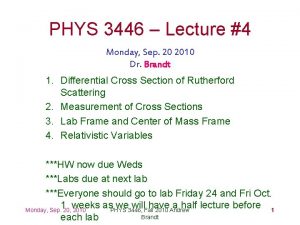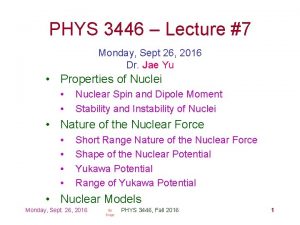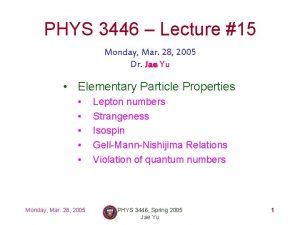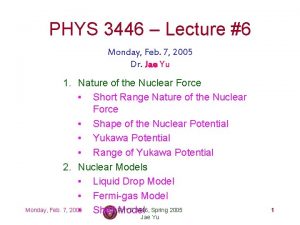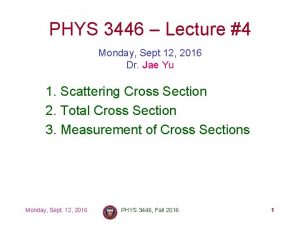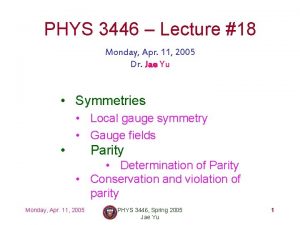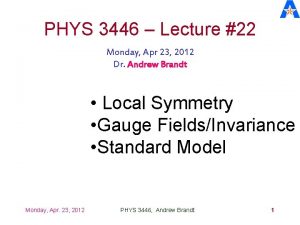PHYS 3446 Lecture 13 Monday Oct 23 2006
























- Slides: 24

PHYS 3446 – Lecture #13 Monday, Oct. 23, 2006 Dr. Jae Yu 1. Particle Detection • • Scintillation Counters Time of Flight Cerenkov Counter Calorimeters 2. Particle Accelerators • Monday, Oct. 23, 2006 Electrostatic Accelerators PHYS 3446, Fall 2006 Jae Yu 1

Announcements • Research Day tomorrow – Rio Grande – – – • 9 am – 4 pm poster presentations Our cloud chamber prototype will be in display from noon – 4 pm Need presenters to operate the chamber and man the poster Next LPCC Workshop – Preparation work • • – • CPB 303 and HEP experimental areas Quiz results – – • Class average: 68. 5 Top score: 96/90 Assignments 1. 2. 1. Lists of goals and items to purchase? 10 am – 5 pm, Saturday, Nov. 4 Derive Eq. 7. 10 Carry out computations for Eq. 7. 14 and 7. 17 Due for these assignments is Monday, Oct. 30 Monday, Oct. 23, 2006 PHYS 3446, Fall 2006 Jae Yu 2

Paper Template Monday, Oct. 23, 2006 PHYS 3446, Fall 2006 Jae Yu 3

Scintillation Counters • Two types of scintillators – Organic or plastic • Tend to emit ultra-violate • Wavelength shifters are needed to reduce attenuation • Faster decay time (10 -8 s) • More appropriate for high flux environment – Inorganic or crystalline (Na. I or Cs. I) • Doped with activators that can be excited by electron-hole pairs produced by charged particles in the crystal lattice • These dopants can then be de-excited through photon emission -6 sec • Decay time of order 10 Monday, Oct. 23, 2006 PHYS 3446, Fall 2006 4 Yu • Used in low energy. Jaedetection

Scintillation Counters – Photo-multiplier Tube • The light produced by scintillators are usually too weak to see – Photon signal needs amplification through photomultiplier tubes • Gets the light from scintillator directly or through light guide – Photocathode: Made of material in which valence electrons are loosely bound are easy to cause photo-electric effect (2 – 12 cm diameter) – Series of multiple dynodes that are made of material with relatively low work-function » Operating at an increasing potential difference (100 – 200 PHYS V) difference Monday, Oct. 23, 2006 3446, Fall 2006 between dynodes 5 Jae Yu

Scintillation Counters – Photo-multiplier Tube • The dynodes accelerate the electrons to the next stage, amplifying the signal to a factor of 104 – 107 • Quantum conversion efficiency of photocathode is typically on the order of 0. 25 • Output signal is proportional to the amount of the incident light except for the statistical fluctuation • Takes only a few nano-seconds for signal processing • Used in as trigger or in an environment that requires fast response • Scintillator+PMT charged particles or Monday, Oct. 23, 2006 good detector PHYS 3446, for Fall 2006 6 Jae Yu photons or neutrons

Some PMT’s Monday, Oct. 23, 2006 PHYS 3446, Fall 2006 Jae Yu Super-Kamiokande detecto 7

Scintillation Detector Structure HV PS Scintillation Counter Light Guide/ Wavelength Shifter PMT Readout Electronics Scope Monday, Oct. 23, 2006 PHYS 3446, Fall 2006 Jae Yu 8

Time of Flight • Scintillator + PMT can provide time resolution of 0. 1 ns. – What position resolution does this corresponds to? • 3 cm • Array of scintillation counters can be used to measure the time of flight (TOF) of particles and obtain their velocities – What can this be used for? • Can use this to distinguish particles with about the same momentum but with different mass – How? • Measure – the momentum (p) of a particle in the magnetic field – its time of flight (t) for reaching some scintillation counter at a distance L from the point of origin of the particle Monday, Oct. 23, 2006 PHYS 3446, Fall 2006 9 – Determine the velocity of the particle and its mass Jae Yu

Time of Flight (TOF) • TOF is the distance traveled divided by the speed of the particle, t=L/v. • Thus Dt in flight time of the two particle with m 1 and m 2 is • For known momentum, p, – Since • In non-relativistic limit, • Mass resolution of ~1% is achievable for low Monday, Oct. 23, 2006 PHYS 3446, Fall 2006 energies Jae Yu 10

Cerenkov Detectors • What is the Cerenkov radiation? – Emission of coherent radiation from the excitation of atoms and molecules • When does this occur? – If a charged particle enters a dielectric medium with a speed faster than light in the medium – How is this possible? • Since the speed of light is c/n in a medium with index of refraction n, if the particle’s b>1/n, its speed is larger than the speed of light • Cerenkov light has various frequencies but blue and ultraviolet band are most interesting – Blue can be directly detected w/ standard PMTs – Ultraviolet can be converted to electrons using photosensitive molecules mixed in with some gas in an ionization chamber Monday, Oct. 23, 2006 PHYS 3446, Fall 2006 Jae Yu 11

Cerenkov Detectors • The angle of emission is given by • The intensity of the produced radiation per unit length of the radiator is proportional to sin 2 qc. • For bn>1, light can be emitted while for bn<1, no light can be observed. • Thus, Cerenkov effect provides a means for distinguishing particles with the same momentum – One can use multiple chambers of various indices of refraction to detect Monday, Oct. 23, 2006 PHYS 3446, Fall 2006 Cerenkov radiation 12 Jae Yu from particles of different mass but with the

Cerenkov Detectors • Threshold counters – Particles with the same momentum but with different mass will start emitting Cerenkov light when the index of refraction is above a certain threshold – These counters have one type of gas but could vary the pressure in the chamber to change the index of refraction to distinguish particles – Large proton decay experiments use Cerenkov detector to detect the final state particles, such as p e+p 0 • Differential counters – Measure the angle of emission for the given index of refraction since the emission angle for lighter particles will be larger than heavier ones Monday, Oct. 23, 2006 PHYS 3446, Fall 2006 Jae Yu 13

Super Kamiokande A Differential Water Cerenkov Detector • Kamioka zinc mine, Japan • 1000 m underground • 40 m (d) x 40 m(h) SS • 50, 000 tons of ultra pure H 2 O • 11200(inner)+1800(outer ) 50 cm PMT’s • Originally for proton decay experiment • Accident in Nov. 2001, destroyed 7000 PMT’s Monday, Oct. 23, 2006 PHYS 3446, Fall 2006 • Dec. 2002 resumed data. Jae Yu 14

Super-K Event Displays Stopping m Monday, Oct. 23, 2006 3 m PHYS 3446, Fall 2006 Jae Yu 15

Cerenkov Detectors • Ring-imaging Cerenkov Counters (RICH) – Use UV emissions – An energetic charged particle can produce multiple UV distributed about the direction of the particle – These UV photons can then be put through a photosensitive medium creating a ring of electrons – These electrons then can be detected in an ionization chamber forming a ring – Babar experiment at SLAC uses this detector Monday, Oct. 23, 2006 PHYS 3446, Fall 2006 Jae Yu 16

Semiconductor Detectors • Semiconductors can produce large signal (electronhole pairs) for relatively small energy deposit (~3 e. V) – Advantageous in measuring low energy at high resolution • Silicon strip and pixel detectors are widely used for high precision position measurements – Due to large electron-hole pair production, thin layers (200 – 300 mm) of wafers sufficient for measurements – Output signal proportional to the ionization loss – Low bias voltages sufficient to operate – Can be deposit in thin stripes (20 – 50 mm) on thin electrode – High position resolution achievable – Can be used to distinguish particles in multiple detector configurations • So what is the catch? 23, 2006 PHYS 3446, Fall 2006 2 –Monday, Very. Oct. expensive On the order of $30 k/m Jae Yu 17

DØ Silicon Vertex Detector 8 1 9 11 12 0 6 7 5 2 43 1 1 6 . 1. . … 2 One Si detector 3 4 Monday, Oct. 23, 2006 Barrel Disk PHYS 3446, Fall 2006 Jae Yu 18

Calorimeters • Magnetic measurement of momentum is not sufficient for physics, why? – The precision for angular measurements gets worse as particles’ momenta increases – Increasing magnetic field or increasing precision of the tracking device will help but will be expensive – Cannot measure neutral particle momenta • How do we solve this problem? – Use a device that measures kinetic energies of particles • Calorimeter – A device that absorbs kinetic energy of a 19 PHYS 3446, full Fall 2006 Jae Yu particle Monday, Oct. 23, 2006

Calorimeters • Large scale calorimeter were developed during 1960 s – For energetic cosmic rays – For particles produced in accelerator experiments • How do high energy EM (photons and electrons) and Hadronic particles deposit their energies? – Electrons: via bremsstrahlung – Photons: via electron-positron conversion, followed by bremsstrahlung of electrons and positrons Oct. 23, 2006 PHYS 3446, Fall 2006 –Monday, These processes continue occurring in the Jae Yu 20

Electron Shower Process Photon, g Monday, Oct. 23, 2006 PHYS 3446, Fall 2006 Jae Yu 21

Calorimeters • Hadrons are massive thus their energy deposit via brem is small • They lose their energies through multiple nuclear collisions • Incident hadron produces multiple pions and other secondary hadrons in the first collision • The secondary hadrons then successively undergo nuclear collisions • Mean free path for nuclear collisions is called nuclear interaction lengths and is substantially larger than that of EM particles • Hadronic shower processes are therefore more erratic than EM shower processes Monday, Oct. 23, 2006 PHYS 3446, Fall 2006 Jae Yu 22

Sampling Calorimeters • High energy particles require large calorimeters to absorb all of their energies and measure them fully in the device (called total absorption calorimeters) • Since the number of shower particles is proportional to the energy of the incident particles • One can deduce the total energy of the particle by measuring only the fraction of their energy, as long as the fraction is known Called sampling calorimeters – Most the high energy experiments use sampling calorimeters Monday, Oct. 23, 2006 PHYS 3446, Fall 2006 Jae Yu 23

How particle showers look in detectors Hadron EM Monday, Oct. 23, 2006 PHYS 3446, Fall 2006 Jae Yu 24
 Phys 241 purdue
Phys 241 purdue 01:640:244 lecture notes - lecture 15: plat, idah, farad
01:640:244 lecture notes - lecture 15: plat, idah, farad Jhlt. 2019 oct; 38(10): 1015-1066
Jhlt. 2019 oct; 38(10): 1015-1066 Met et prop but pent hex hept oct non dec
Met et prop but pent hex hept oct non dec Oct spectralis
Oct spectralis Forneça a nomenclatura correta para os seguintes alcinos
Forneça a nomenclatura correta para os seguintes alcinos Quad pent hex hept oct
Quad pent hex hept oct Ims design software
Ims design software Prop but pent hex hept oct
Prop but pent hex hept oct Low na
Low na Jhlt. 2019 oct; 38(10): 1015-1066
Jhlt. 2019 oct; 38(10): 1015-1066 Visante oct
Visante oct Scleral lens oct
Scleral lens oct Homologous family
Homologous family About mahatma gandhi in english
About mahatma gandhi in english Propil
Propil But prop
But prop General formula of alkane
General formula of alkane Meth eth prop but mnemonic
Meth eth prop but mnemonic Propylhexane formule semi-développée
Propylhexane formule semi-développée Jhlt. 2019 oct; 38(10): 1015-1066
Jhlt. 2019 oct; 38(10): 1015-1066 Whats emplid
Whats emplid Dodawanie w systemie czwórkowym
Dodawanie w systemie czwórkowym Chemistry organic
Chemistry organic Oct vizsgálat
Oct vizsgálat




